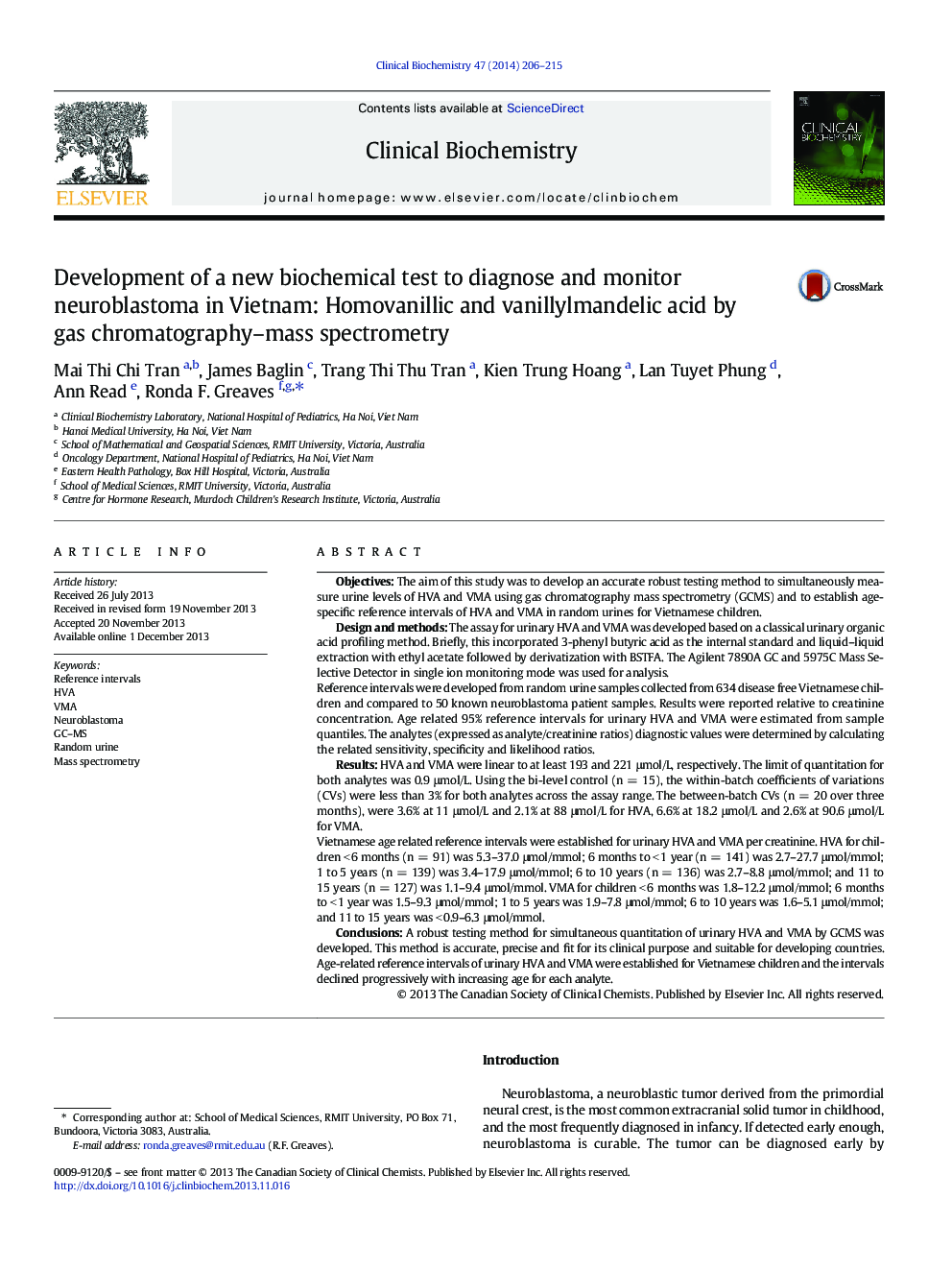| کد مقاله | کد نشریه | سال انتشار | مقاله انگلیسی | نسخه تمام متن |
|---|---|---|---|---|
| 1968992 | 1059756 | 2014 | 10 صفحه PDF | دانلود رایگان |

• Development of cost effective and robust GCMS urinary HVA and VMA quantitation method.
• Establishment of random urinary HVA and VMA reference intervals for Vietnamese children.
• The intervals declined progressively with increasing age for each analyte.
• Estimation of the likelihood ratios of urinary HVA and VMA.
ObjectivesThe aim of this study was to develop an accurate robust testing method to simultaneously measure urine levels of HVA and VMA using gas chromatography mass spectrometry (GCMS) and to establish age-specific reference intervals of HVA and VMA in random urines for Vietnamese children.Design and methodsThe assay for urinary HVA and VMA was developed based on a classical urinary organic acid profiling method. Briefly, this incorporated 3-phenyl butyric acid as the internal standard and liquid–liquid extraction with ethyl acetate followed by derivatization with BSTFA. The Agilent 7890A GC and 5975C Mass Selective Detector in single ion monitoring mode was used for analysis.Reference intervals were developed from random urine samples collected from 634 disease free Vietnamese children and compared to 50 known neuroblastoma patient samples. Results were reported relative to creatinine concentration. Age related 95% reference intervals for urinary HVA and VMA were estimated from sample quantiles. The analytes (expressed as analyte/creatinine ratios) diagnostic values were determined by calculating the related sensitivity, specificity and likelihood ratios.ResultsHVA and VMA were linear to at least 193 and 221 μmol/L, respectively. The limit of quantitation for both analytes was 0.9 μmol/L. Using the bi-level control (n = 15), the within-batch coefficients of variations (CVs) were less than 3% for both analytes across the assay range. The between-batch CVs (n = 20 over three months), were 3.6% at 11 μmol/L and 2.1% at 88 μmol/L for HVA, 6.6% at 18.2 μmol/L and 2.6% at 90.6 μmol/L for VMA.Vietnamese age related reference intervals were established for urinary HVA and VMA per creatinine. HVA for children < 6 months (n = 91) was 5.3–37.0 μmol/mmol; 6 months to < 1 year (n = 141) was 2.7–27.7 μmol/mmol; 1 to 5 years (n = 139) was 3.4–17.9 μmol/mmol; 6 to 10 years (n = 136) was 2.7–8.8 μmol/mmol; and 11 to 15 years (n = 127) was 1.1–9.4 μmol/mmol. VMA for children < 6 months was 1.8–12.2 μmol/mmol; 6 months to < 1 year was 1.5–9.3 μmol/mmol; 1 to 5 years was 1.9–7.8 μmol/mmol; 6 to 10 years was 1.6–5.1 μmol/mmol; and 11 to 15 years was < 0.9–6.3 μmol/mmol.ConclusionsA robust testing method for simultaneous quantitation of urinary HVA and VMA by GCMS was developed. This method is accurate, precise and fit for its clinical purpose and suitable for developing countries. Age-related reference intervals of urinary HVA and VMA were established for Vietnamese children and the intervals declined progressively with increasing age for each analyte.
Journal: Clinical Biochemistry - Volume 47, Issue 3, February 2014, Pages 206–215